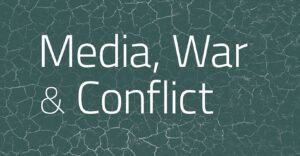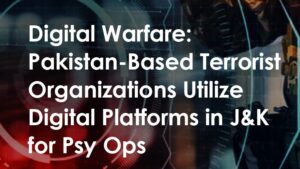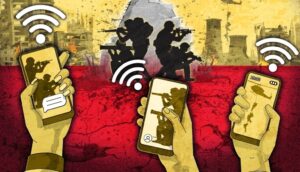Jaibans Singh

Starting from the Indo-Pakistan War, 1947-48 through all conflicts that our nation has faced, including insurgency; proxy and asymmetric warfare, the crib about poor information and communication processes has been constant.
There is a wide ranging perception that our inimical neighbours, China and Pakistan, have always had an upper hand in the information domain. This perception has gained further leverage during Operation Sindoor with volumes being written about our communication weakness and its exploitation by the enemy.
If a country can, from scratch, develop strategic capability in the nuclear, space and missile technology domains and emerge as a world leader, surely it can also work out the relatively easier communication structure. So, what is the hold-up? The question needs deep analysis.
Perceived Fault Lines in Indian Information Systems
There is a perception that Pakistan and China have a more structured media set-up that responds immediately in times of conflict with pre-packaged media tool-kits hastily synchronised with the emerging situation. By doing so, they ensure a speed of response that puts India into a reaction mode.
“While the operational goals may have been partially achieved, the battle for narratives has slipped from our grasp. The lessons from this engagement extend beyond the battlefield and into the realms of perception, intent, and the importance of clear strategic communication,” says Lt. Col. Manoj Channan, a military veteran who writes extensively on defence and security matters.
It is widely believed that the capacity of Pakistan and China to convert blatant lies and even half-truths into credible misinformation and disinformation campaigns far outstrips the Indian efforts. They do not hesitate from using outdated images and borrowed material to prove a point. With the advent of artificial intelligence this policy of theirs will attain a different level altogether.
A consistent worry is expressed about the sophisticated lobbyists and think tanks that the two countries have nurtured the world over. These elements are effectively leveraged to give credibility to a prepared narrative. The narrative created is built upon at the domestic level to complete the cycle of brainwashing of the target audience.
The biggest crib is about social media. It is felt that Pakistan has the capability to peddle its desired narrative on social media in a manner that outstrips Indian capability. A military veteran, Lt. Gen. Shokin Chauhan, who has considerable experience in the Indian military information domain said with regard to Operation Sindoor, “Google Trends data from 5 May, showed that global searches for “Kashmir conflict”, Pakistan’s preferred framing, outpaced searches for “Pahalgam terrorism,” India’s natural framing. Pakistan had successfully redefined the terms of international debate before India had even entered the conversation.” Chauhan also feels that. “The Indian response represented a fundamental misunderstanding of how modern information warfare operates.”
Finally, it is being said that Pakistan manages to manipulate the post conflict narrative towards non-issues to shake off the reality of its defeat. In the instance of Operation Sindoor, it managed to turn focus from the decisive Indian strikes to the Rafale vs. J-10 debate. India is thus compelled into pursuing a defensive line instead of setting the agenda.
The aforementioned are relevant points. However, they do not take into consideration the environment under which India builds the information and perception spectrum.
Eco-system of Governance
It is a well-established fact that authoritarian regimes (fascist, communist, dictatorship) retain full and unscrupulous control over the information domain of their nations and carry out propaganda (battle of perception) far more strongly than a democracy since the latter follows the highest principles information ethics. This fact was firmly established during World War II, wherein, the Joseph Goebbels led German propaganda machinery dominated the allied media effort for a major part of the war.
The fact that Pakistan and China are authoritarian regimes while India is the largest and most vibrant democracy in the world does impact the information domain. In Pakistan, the Inter Services Public Relations (ISPR) of the Pakistan army maintains a vice-like grip on the media which is told what to highlight and what to suppress. There are some independent voices that have probably been kept active to give an impression of freedom of press, they pale into insignificance under the weight of the army sponsored narrative.
The Communist Party of China publicly acknowledges that party control over the media is an essential tenet of national security. Its Central Propagandas Department oversees and regulates media. The country also has many state owned media outlets like the Xinhua News Agency and the China Media Group.
The media iron curtain and unlimited access to slush funds gives these two countries the leverage to create lobbies not only within the state but across the world.

The Indian Constitution guarantees freedom of speech and expression to all citizens through Article 19 (1) (a). The Indian media, therefore, has the freedom to interpret, re-pack and deliver information provided by the government in whatever manner it deems fit. This system in principled but has inherent challenges when it competes with the neighbouring inimical countries.
The Indian bureaucracy has, over time, developed a methodology of maintaining “strategic silence” instead of the “strategic clarity” that the media demands and then exploits. It may not be the best option but it is definitely the most viable damage control alternative.
The open engagements of lobbies by the government as is being done by Pakistan and China would spell political suicide in India. Successive governments in India, therefore, may have nurtured lobbies albeit covertly and in a restrained manner. The system does not match up to authoritarian practices.
The Indian Army being apolitical in nature has maintained a tradition of avoiding contact with media wherever and whenever possible. In the modern context it has a very sensitive balance to maintain between release of information and maintenance of operational confidentiality against the backdrop of aggressive media and a public that remain hungry for information.
Definitely, the organisation cannot and should not succumb to the pressure and release information as the media demands. The gap in practicality and aspirations between the organisation and the media has to remain.
Geography and Demography
India is four times larger than Pakistan in terms of land mass and has six times more population. China is bigger and more populous than India but this does not matter since no one there can speak or express opinions unless authorised to do so. Stepping out of turn elicits terrible repercussions ranging from imprisonment to death.
A vast majority of the Indian populace does not experience the vagaries of living in border areas that have close proximity to inimical neighbours. While there is no dearth in nationalism, knowledge about security issues is limited. A major segment of the country, therefore, is vulnerable to the propaganda initiatives of the enemy which creates a serious situation for the government regardless of the political party in power.
The Media Factor
Mature and responsible Armed Forces disseminate information through a chain of command. In the course of a military operation, the forces give out a press release only after proper verification and assessment and through a Headquarter normally not below the Theatre level. Briefing is traditionally done twice a day.
The news, on the other hand, travels like lightning. The media is shrill, aggressive, obsessed with sensationalising loss and always looking for the breaking news. By the time the official version comes out, the matter has been shred to bits by the media and not always in the correct perspective.
Here lies a Catch-22 situation. Should the Armed Forces reinvent their systems to integrate the time-lines of the media or should they continue to follow traditional procedures that have stood the test of time?
Indian media has a predominant tilt towards politics and cricket. As a result, journalists in all fields other than politics form the lower rung. Defence comes in the bottom of the pecking order. Defence reporting, therefore, lacks both manpower and professionalism. The coverage of conflict situations by the Indian Television media come across as blatant jingoism. It is technically and professionally uninformed and strategically misleading. The debates are based on innuendoes and ambiguities. Articles by so-called experts carried by newspapers are full of inaccuracies.

Social media has added another very dangerous dimension to the ecosystem.
Most of the defence oriented media establishments survive on advertisements from the weapon producing industry and agents. They have no option but to cater for a security posture that suits their clients which, in many cases, does not represent national interest. The constitutional right to freedom of speech precludes legal action against the establishments.
The bottom line is that the forces and the government may embed any number of journalists and provide any amount of information, the end product will be packaged in a manner that can give TRPs and circulation. Advertisements and brokerage of power rules the roost.
Human nature is such that negative happenings gain more attention. Winning gets less hype than losing. The end result is that a victory has to be turned into a defeat in order to keep the interest alive. Social media plays an even bigger role in creating this sense of insecurity.
An environment as articulated above when assisted by constitutional provisions of freedom of speech and expression seriously impinges upon defence and security reporting. It is no wonder that despite extraordinary success and achievements in all forms of conflict that the armed forces of the country have been engaged in since independence, none is looked upon as a resounding success.
The Political Domain
As with the general populace, the political leadership of the nation also, by and large, remains quite divorced from military and strategic knowledge. It is no wonder then that security is looked upon as an extension of politics when, in actuality, it should remain totally divorced from politics.
In the instance of a security emergency, the opposition grudgingly extends all support to the government only to open up its fangs the moment the situation stabilises. Then the questions and doubts start pouring in. Comments and statements are designed to influence that segment of society that forms the constituency of the political leader. Facts are ignored blatantly even as the exhibition of limited knowledge is palpable. The opposition offers critiques for every military action only for the sake of opposition. The media has a field day in playing one against the other.
The political class, whether in the government or in the opposition, fails to comprehend that though their critiques are directed towards parties in opposition, ultimately it is the Armed Forces that remain in the line of fire.
Conclusions
As a mature democracy poised to become a global power and facing multiple security challenges due to an inimical neighbourhood, India needs to cultivate maturity in dealing with national security. The basics are in place but they give way to petty political considerations.
It would be best for the political parties to keep security out of the political process. The political parties can earn their brownie points in the many other areas available. The political class also needs to educate itself on security issues in order to make a meaningful contribution.
Security is too serious a business to be leveraged for the sake of professional media advancement. The media needs to self-regulate and leave national security out of its dog eat dog and TRP/circulation centric policy.
More attention needs to be given to defence journalism. Fact checks before release of information and its professional packaging is a national security necessity. A balance has to be worked out between the need for speedy dissemination and accurate reporting. Reports should be verified, even if it means losing out on the breaking news. Most importantly, the maverick loose-cannons that have dubious global connections have to be exposed and dealt with under legitimate legal and constitutional provisions.
Global powers ultimately make assessments on the basis of their own intelligence inputs. Pakistan may cry hoarse about its victory in the recent face-off with India (Operation Sindoor) but the facts are not hidden from the global leaders.
There are many aspects where the government should develop a proactive stand. Pakistan’s attempt to play the victim card and project Kashmiris as suppressed people needs to be challenged with effective media articulation. Also, the underlying psyche of the western world that remains more concerned with the humane and political dimensions of the conflict needs to be understood and addressed with sensitivity.

We have to fine tune our systems in a manner that leads to recognition and respect of our power and our principled posture.
The Armed Forces are accountable to the Nation and the incumbent government, not to the media. They are mandated to fight and win a war with no responsibility towards the TRP battle. If aspects of media intransigence need engagement, the government should take on the responsibility.
The parameters of “right to know” and “right to disclose” in security affairs need to be given a re-thought and a “fair to all” policy needs to be put in place. All information stakeholders, the providers, the packagers and the end users should be very clear about the parameters. Crossing the threshold should invite consequences.
It all boils down to power. A dominant position can be achieved by a nation only if it is strong or geo-strategically useful. China is strong. Pakistan is geo-strategically useful and willing to sell itself to the highest bidder. To break this cycle India has to strive to gain a position of strength for which economic power and technological domination is necessary.
The need to educate and prepare the nation for War and other forms of conflict is a valuable lesson that has emerged from Operation Sindoor.
People and institutions need to be made to understand that wars are not fought by armies alone, citizens and institutions have duties to perform and responsibilities to shoulder. The slightest weakness in the chain will be exploited by the enemy to his advantage. This training and education should start from the school curriculum and continue to all levels. Regular refresher courses and workshops are necessary. For this organisations like NCC, boy scouts, civil defence etc. need to be strengthened. Those breaking the protocol need to be exposed and meted exemplary punishment as per law.
Finally, it is the people who count. In matters of national security, people tend to repose faith in strong leaders. German propaganda failed in the face of the persona of Winston Churchill. The people of India need to maintain faith in their prime minister and their Armed Forces. Ultimately, the truth will prevail. Protection of the national information space is the duty of every citizen of the country.
Note – First Published in Indian Defense Review (IDR)